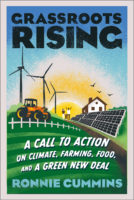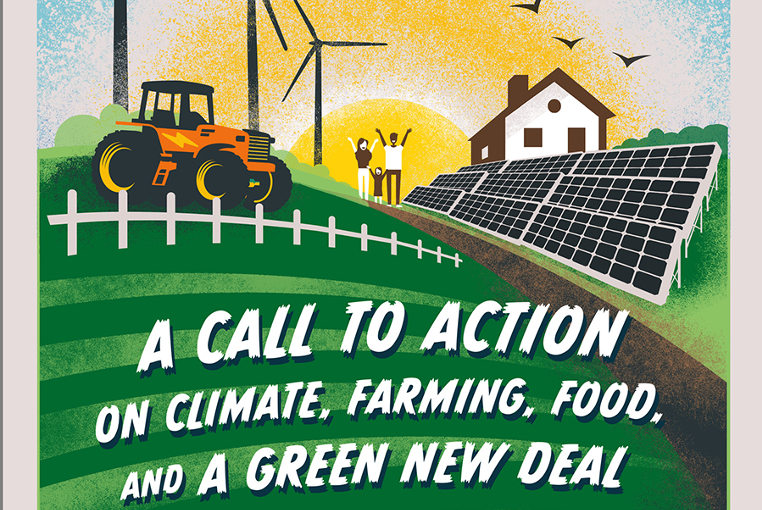 Ready to organize and do your part to prevent ecological collapse? Grassroots Rising by Ronnie Cummins is your shovel-ready instruction manual for fixing a broken climate.
Ready to organize and do your part to prevent ecological collapse? Grassroots Rising by Ronnie Cummins is your shovel-ready instruction manual for fixing a broken climate.
Educational and inspiring, this new book shows that a worldwide grassroots Regeneration Movement based on consumer activism, farmer innovation, political change, and regenerative finance can offer realistic climate solutions while also meeting our everyday needs.
The following excerpt is from Ronnie Cummins’ new book Grassroots Rising: A Call to Action on Climate, Farming, Food, and A Green New Deal (Chelsea Green Publishing, February 2020) and is reprinted with permission from the publisher.
Scaling Up Regenerative Best Practices
The most important thing that we—the global organic and Regeneration movement, including farmers, businesses, food-chain workers, and consumers alike—have to understand is that we’re running out of time. We know the best way to do things, but our best practices are not spreading fast enough. We no longer have the luxury of remaining apolitical, of working primarily at the micro scale as we build up our organic permaculture farms, ranches, and local landscapes. We must move beyond wishful thinking, beyond believing that somehow we can convert the world’s 570 million farms to organic and regenerative practices in the time frame we have left with just our own internal resources, expertise, and market clout. We need to move beyond ingrained habits and activist business-as-usual attitudes and join up with others, locally, nationally, and internationally. We need to turn every green-minded political activist into a conscious promoter of regenerative food and farming. And we need to turn every organic food consumer and farmer into a politically active proponent of a Green New Deal.
We need to scale up best practices, not just marginally better practices, on a critical mass of the world’s four billion acres of croplands, eight billion acres of grazing lands, and ten billion acres of forests. To do this requires that we carry out a thorough and ongoing global mapping (i.e., locating and publicizing) of the best farm and land management practices that currently exist. The good news is that these best practices are potentially applicable to billions of acres, appropriate to different ecosystems, traditions, and farming conditions around the planet, and at the level sufficient to get us out of the predicament we face. In Eric Toensmeier’s Carbon Farming Solution, in the anthology Drawdown (edited by Paul Hawken), and in practical farming journals across the world, such as those published by the Rodale Institute and Acres USA, there are numerous examples of farming, grazing, and agroforestry practices that are now sequestering and fixing from one to sixteen tons of carbon per acre every year. Given that we have twenty-two billion acres of croplands, rangelands, and forested areas to regenerate, along with several billion acres of wastelands, it is clear that we can reach our goal of sequestering five to twenty billion tons of carbon annually if we scale up best practices, especially agroforestry, silvopasture, and forest polycultures in the tropical and subtropical areas of the Global South, combined with regenerative organic agriculture and holistic livestock management in the Global North.
Articles in academic scientific journals that routinely underestimate the capacity for global soil carbon sequestration (saying, for example, that the best we can do is to mitigate 1 to 20 percent of current emissions, or a couple of billion tons of carbon per year) are ignoring the amazing sequestration practices already taking place on today’s leading regenerative farms, ranches, and ecosystem restoration projects. At the same time, many academic “experts” are proclaiming, with little or no supporting evidence, that genetically engineered “climate-friendly” or drought-resistant crops or trees can significantly mitigate climate change. Other indentured academics praise marginally improved (corporate-sponsored) “climate- smart agriculture” practices, whereby commodity farmers use a reduced amount of soil-killing, biodiversity-destroying chemical fertilizers and pesticides, along with GMO seeds, $500,000 computerized tractors, and Big Data. In reality, none of these expensive high-tech schemes will eliminate food and farming emissions, much less rebuild natural soil fertility and supercharge soil sequestration.
The primarily low-tech, shovel-ready, affordable solutions that we need already exist in every nation and region. Millions of farms are already utilizing the traditional best practices of forest agriculture and forest gardens, organic and agroecological methods, holistic grazing, and soil conservation practices, augmented by recent innovations in permaculture, agroforestry, silvopasture, and landscape restoration. We don’t need to invent new techniques. We simply need to identify, publicize, replicate, and scale up currently existing best practices utilizing farmer-to-farmer education and training, with major support and funding from the public and private sectors.
Our roadmap and planning must be based upon the understanding that our industrial and degenerative food and farming system is not just a small factor in global warming but a major cause of it (44 to 57 percent of all GHGs come from our globalized and industrialized food and farming system), and that traditional, organic, and regenerative practices—already being practiced in thousands of communities—offer not just slight mitigation but, in fact, a practical means to reverse climate change.
One of the unfortunate characteristics of most academic scientists today is their overreliance on the very limited number of on-the-ground farm studies published in peer-reviewed academic journals, rather than real-world developments, best practices, and breakthroughs. The same goes for mainstream journalists, who typically rely almost exclusively on these same academic experts and citations in the establishment press. The routine lack of imagination, overspecialization, and compartmentalization of science and journalism and the low estimates of the potential of regenerative carbon sequestration have now become especially dangerous, given our current climate emergency. Climate scientists, alternative energy advocates, politicians, and journalists who know little or nothing about farming, soil science, and carbon sequestration are not reliable sources of information on what is possible. Farmers, especially in the tropical and subtropical regions, sequestering five to fifteen tons of carbon per acre per year through agroforestry and silvopasture techniques, are typically not recognized in peer-reviewed scientific journals, nor are ranchers and others on the cutting edge of holistic management in Australia, North America, South America, and southern Africa, who have increased the soil carbon content on their farms and pastures sixfold or even twelvefold.
Breaking Through the Final Roadblocks
We have the means and the working models we need for a global green economy and regenerative food, farming, and land use practices, but we lack the consumer awareness, political power, and economic resources to scale these practices up into a new Regenerative Commonwealth. Climate-denying fossil fuel companies, nation-states that depend upon petroleum exports, and the global industrial agriculture of the Big Food cartel, along with corrupt politicians they have in their pocket, are the major adversaries we must overcome. But false consciousness, cynicism, and fatalism are the other obstacles blocking our way to Regeneration. Parochial and nationalistic prejudices have spread like a cancer. Self-destructive lifestyles and deeply ingrained consumer habits and addictions have further sapped the energy of the global grassroots. The body politic and global civil society in most nations of the world are still divided, bogged down by pressing individual concerns and separated by cultural, economic, ethnic, and religious differences. Hypercompetitive trade relations and geopolitical conflict between the world’s largest GHG emitters (the United States, China, Russia, India, and the European Union) drive politicians and corporations to delay or reduce investments in renewable energy and lower pollution and environmental standards so as to maintain corporate profits and the gross national product.
On the current (climate-destabilizing, land-degrading) food and farming front, the seemingly insatiable appetite of consumers in Europe, China, and United States for cheap (factory-farmed) meat and animal products drives the expansion of GMO animal-feed soybean plantations in Brazil, Paraguay, and Argentina, destroying the Amazon (often referred to as “the lungs of the planet”), as well as the once massive (and carbon- sequestering) grasslands and savannas of Latin America. Similarly, the Global North’s lust for biofuels, cheap cooking oils for processed food, and cheap ingredients for body care products has spawned the destructive growth of palm oil plantations in Indonesia and many of the world’s other tropical rainforest (and peatland) areas, undermining the rich biodiversity and massive natural carbon sequestration of these tropical forests.
Low-grade, subsidized food exports continue to be dumped by the Global North in the markets of the Global South, eroding public health, making it harder for traditional agroecological small farmers and graziers to maintain their regenerative or potentially regenerative farming practices, and undermining the South’s ability to feed itself, employ its people, and maintain traditional social structures. That imbalance contributes to the ongoing forced migration of millions of people from the Global South. Fleeing violence and rural poverty (exacerbated by climate change), they are desperately attempting to cross seas and borders and find work in Europe, the United States, and other countries, setting off a wave of fear and xenophobia and enabling neo-fascist Earth destroyers and climate deniers like Trump in the United States and Bolsonaro in Brazil to gain power.
Yet perhaps the biggest obstacle we face on the road to Regeneration is the multitrillion-dollar military-industrial complex, in both the United States and other nations. Politicians complain that there’s not enough money to finance climate change mitigation or a GND, but meanwhile there always seems to be money for massive military spending. Endless war and the trillion-dollar international trade in armaments are manifestations of not only the struggle to control fossil fuels, precious minerals, and other strategic resources but a self-destructive, nationalistic ideology of fear and distrust that justifies the status quo and pits countries, ethnic groups, and religious sects against one another. We can either continue with business as usual (my country and my people are better than your country and your people) and allow our multitrillion-dollar military-industrial complex to wage war and sow fear, or we can work together as part of a global New Deal, reverse global warming, and address all the other rapidly oncoming disasters of the modern age. Judgment Day has arrived. The time for action is now.
Given our shared predicament, my hope is that you’re ready to step forward, take action, and join the growing ranks of Regenerators, either as an active leader in the front lines of advocacy and mobilization or as a supporter, donor, messenger, and practitioner of Regeneration in your local community. We are indeed cursed to be living in an age of crisis and Degeneration, but we are blessed to be living in an age of Regeneration as well. Never before have humans faced such a serious threat to our survival. But never before have we had the knowledge, the tools, the economic power, and the grassroots human resources to not only survive our terminal crisis, but to thrive. Never before have global subjective and objective conditions been so ripe for fundamental change.
Revolutionaries and visionaries have been dreaming about global peace and transformation for two hundred years in the face of what turned out to be insurmountable odds. But now the balance of consciousness and power is shifting. We, the global civil society and the global body politic, finally have the opportunity to push forward with life-saving renewable and regenerative practices and policies as part of a world-changing coalition, both in the United States and globally. But the hour is late. What we do, or fail to do, today, tomorrow, and for the rest of this decade, is crucial. Our actions, not in a generation, but now and in the next ten years, will likely determine the future of our species.





